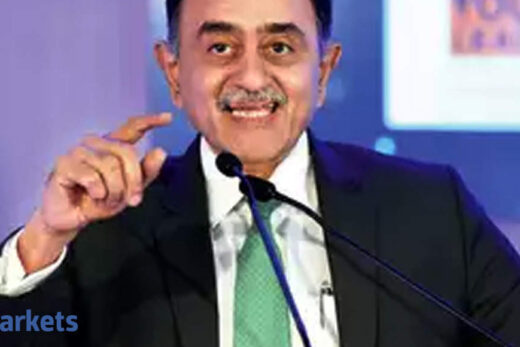It is turning out to be a dream year for every market participant. As we unwind the year, will the dream turn into a nightmare given what is happening to commodity prices, bond yields and FII selling?
It does not look like that. Obviously the market is expensive, almost 22 times on a March 23 basis. But having said that, I do not know what could be the big negative trigger which results in a big re-rating of the market.
Yes, bond yields will move and expectations on bond yields will rise over a period of time but the expectation as of now is that bond yields rise in a very gradual manner and moderately over a period of time. Our own expectation is maybe it will rise between 50 and 100 bps, as far as India is concerned over the next year to 18 months. At the same time, you would also have fairly strong economic revival and earnings recovery on the back of that. So we are looking at about 34% growth in profits of the Nifty 50 index for March 22 followed by another 15% for March 23. Hopefully, whatever increase in bond yields we see to some extent gets offset by increase in earnings numbers and earnings yields at the same time.
I just hope that over the next four-five months, inflation data points start turning down globally. It will result in the market having a lot more comfort with whatever narrative, currently that inflation is transitory and it will come off and central banks would not be forced to bring forward strategies in terms of raising interest rates. So let us keep the fingers crossed on inflation. Unfortunately, it looks like inflation is going to be on the higher side and over the next few months, it will start moving up in India. I just hope it remains under check and central banks and the market do not get a rude shock over here.
For someone who has valued companies based on enterprise value, cost of asset, replacement cost, how one should participate in these new age tech companies. A Paytm or a Zomato are now bigger than a lot of big companies. There is this feeling at the back of your mind that it would be a cardinal sin to buy companies which are loss making and have no profit projections.
Not necessarily. It can be done if you have some sense of what the market opportunity is in most of these markets in a 10-15-year timeframe. India is expected to grow and one can have a reasonably good sense of what will be the market opportunity for each of these segments over the next 5-10 years. One can work backward in terms of what kind of revenue numbers one should build in for the major participants in that particular space.
If you look at food delivery, we are looking at an almost $8 billion food delivery market by FY2030 and as of now, it looks like it is a two player market. That gives us some amount of comfort. Obviously, in some of the segments, we still do not know what the competitive landscape is like, how many players will emerge going forward and whether the market is taking care. So, a lot of variables are still out, which makes it trickier to divide the market opportunity or TAM as we call it, between various market participants.
One will have to look at every segment on a very top-down basis in terms of sizing the market probably and then on bottom-up basis in terms of the capability of each of these companies to participate in the opportunity.
At least in the initial stages, it is possible to expect that each of these companies will be very successful. As the landscape evolves, we have to see how many of these companies eventually succeed but the danger is that if we are already implying a lot of market cap and market opportunity, that does not make any sense. So one has to be very careful about the implied market cap of the companies.
I do not know whether we are there in some of the sectors possibly. So we will have to look at each of the segments in a very granular fashion and then take a call.
The dilemma for investors is which side should they lean – new tech or high growth companies which have become big brands in themselves with their ecosystem or should one go back to traditional companies like textile, corporate banks which are making a comeback cyclical and the industrial cycle has also started. One is spoiled for choice?
It is a good problem to have. If you are seeing opportunities and values based on that, it is fine. I do not know why that should be a problem. One doesn’t necessarily have to get into any particular set of sectors or stocks. If you find value in even some of the traditional sectors, that is fine. But obviously one will have to be careful when looking at some of these opportunities and see if they will last for a longish period of time.
The danger is in India, things always get extrapolated very quickly. Even for cyclical commodity businesses, the general assumption or implied assumption is that the commodity prices and profitability will stay high for a longish period of time and that need not be the case.
The danger is that based on this assumption, people start giving very high multiples and that is where the real problem starts. I guess there are no hard and fast rules about these things. One has to do a bottom-up match for each of the sectors, each of the stocks and see what is the price value equation. If it makes sense, then one can look at the stocks favourably. If your bottom up fair value is 100, stock price is 150 or so, then why do you need to bother with such companies?
Real estate is making a comeback and how, we have seen a run up in the stock prices. Many of them like DLF are still below the IPO price. What is your strategy when it comes to real estate?
We have been quite positive on the residential real estate cycle for more than a year now and the confidence comes from the fact that over the last several years, the cycle has not gone anywhere.
In the major metropolitan markets, the volumes are still significantly lower than the peak volumes in 2010-2012. So after 10 years of fairly decent growth in the Indian economy, residential real estate volumes are still lower than what used to be a decade back.
Second thing is residential real estate prices have not gone anywhere for the last seven years. Starting from the middle of 2014, it has been pretty much flat across all the major markets.
Thirdly, EMIs are down significantly. Average mortgage rate used to be about 10% plus in FY15. It is 7% now and so there is about 15-17% slippage on EMIs. If we put everything together, affordability is up significantly, the EMIs are down and after Covid, everybody wants to upgrade their house. I guess the cycle can be fairly strong for a very long period of time because residential real estate cycles turn out to be fairly long.
It is not as if there will be one or two year recovery and the story is over. It can be a multiyear investment cycle as far as residential real estate is concerned. It can be played in various ways. One can play the real estate companies which have done very well over the last six, nine months. Many of them have run up significantly. One can play it through construction material, housing finance companies. Some of them are still reasonably valued. So, we have various options to play the residential real estate cycle theme.
The Paytm IPO is the last one of 2021. The next wave will be the Olas, the Delhiveries, the Byjus. But that is expected in the next calendar year. What will all of that mean for allocation to traditional companies in those sectors? That means banks in the case of Paytm, Jubilant Food Works when it comes to Zomato?
I do not know whether anything changes in that sense. Again, one would have to look at each company on its own merit and see whether that makes sense from one’s portfolio perspective or not. The good thing is it is not as if one has to take a call on one versus the other. We may have more stocks in our portfolios that makes sense from a valuation perspective.
Of course we will have to see how many of these companies eventually turn out to be successful companies in the sense of creating value over a period of time because as of now, the expectation is that they could have disproportionate market share, will execute well, will take market share from incumbents and everything will work out fine. But will that narrative plays out or not, we will have to wait and see. It is not as if the incumbents are going to roll over and die.
The whole disruption theme has been talked about quite a lot over the last five, seven years now. Ten years ago, the incumbents were not prepared. If the incumbents are still not prepared, they have a problem in that case. But I assume most of the incumbents when it comes to private sector banks, know what is coming their way in terms of competition from fintechs, whether it is on the payments side or on the lending side.
Accordingly, they will have their own strategies in place with respect to technology, talent, and cooperation with fintechs. Various banks will have their own strategies in place to fight the newcomers. So they have ceded ground to the fintech companies when it comes to payments. I am not sure that will be the case in lending also. The last point I would make here is to keep in mind the fact that India is still in a very early stage of the economic cycle, you have basically a $2,000 per capita economy that will hopefully grow for a very long period of time — three, four decades quite easily.
I guess there is some market opportunity for all players at this point in time. The smarter ones with the right technology and talent combination will do well while others will struggle but I guess that is the nature of the market.



